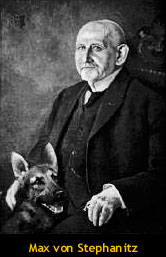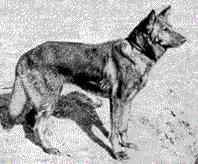|
|
|
||||
 |
History
Origins In Europe, during the 1800s, dog breeds were beginning to be standardized. The dogs were bred to preserve traits that assisted in their job of herding sheep and protecting flocks from predators. In Germany this was practiced within local communities, with the shepherds selecting and breeding dogs together that they believed had good traits, such as intelligence, strength, and keen senses of smell. The results were dogs that were able to perform admirably in their task, but that differed significantly, both in appearance and ability, from one locality to another. To combat these differences, the Phylax Society was formed in 1891 with the intention of creating standardised dog breeds in Germany. The society disbanded after only three years due to an ongoing, internal conflict regarding the traits that the society should promote; some members believed dogs should be bred solely for working purposes, while others believed dogs also should be bred for appearance. While unsuccessful in their goal, the Phylax Society had inspired people to pursue standardising dog breeds independently. Max von Stephanitz, an ex-cavalry captain and former student of the Berlin Veterinary College, was one such ex-member. He believed strongly that dogs should be bred for working. In 1899, Von Stephanitz was attending a show when he was shown a dog named Hektor Linksrhein. Hektor was the product of many generations of selective breeding and completely fulfilled what Von Stephanitz believed a working dog should be. He was pleased with the strength of the dog and was so taken by the animal's intelligence and loyalty, that he purchased it immediately. After purchasing the dog he changed its name to Horand von Grafrath and Von Stephanitz founded the Verein fur Deutsche Schaferhunde (Society for the German Shepherd Dog). Horand was declared to be the first German Shepherd Dog and was the first dog added to the society's breed register. Horand became the centre-point of the society's breeding programs and was bred with dogs belonging to other society members that displayed desirable traits. Although fathering many pups, Horand's most successful was Hektor von Schwaben. Hektor was inbred with another of Horand's offspring and produced Beowulf, who later fathered a total of eighty-four pups, mostly through being inbred with Hektor's other offspring. Beowulf's progeny also were inbred and it is from these pups that all German Shepherds draw a genetic link. It is believed the society accomplished its goal mostly due to Von Stephanitz's strong, uncompromising leadership and he is therefore, credited with being the creator of the German Shepherd Dog. 
Popularity When the UK Kennel Club first accepted registrations for the breed in 1919, fifty-four dogs were registered, and by 1926 this number had inflated to over 8,000. The breed first gained international recognition at the decline of World War I after returning soldiers spoke highly of the breed, and animal actors Rin Tin Tin and Strongheart popularised the breed further. The first German Shepherd Dog registered in the United States was Queen of Switzerland; however, her offspring suffered from defects as the result of poor breeding, which caused the breed to suffer a decline in popularity during the late 1920s. Popularity increased again after the German Shepherd Sieger Pfeffer von Bern became the 1937 and 1938 Grand Victor in American Kennel club dog shows, only to suffer another decline at the conclusion of World War II, due to anti-German sentiment of the time. As time progressed, their popularity increased gradually until 1993, when they became the third most popular breed in the United States, a position the breed still holds. Additionally, the breed is typically among the most popular in other registries. Name The breed was named Deutscher Schaferhund by Von Stephanitz, literally translating to "German Shepherd Dog". The breed was so named due its original purpose of assisting shepherds in herding and protecting sheep. At the time, all other herding dogs in Germany were referred to by this name; they thus became known as Altdeutscher Schaferhunds or Old German Shepherd Dogs. Shepherds were first exported to Britain in 1908, and the UK Kennel Club began to recognise the breed in 1919. The direct translation of the name was adopted for use in the official breed registry; however, at the conclusion of World War I, it was believed that the inclusion of the word "German" would harm the breed's popularity, due to the anti-German sentiment of the era. The breed was officially renamed by the UK Kennel Club to "Alsatian Wolf Dog" which was also adopted by many other international kennel clubs. Eventually the appendage "wolf dog" was dropped. The name Alsatian remained for five decades, until 1977, when successful campaigns by dog enthusiasts pressured the British kennel clubs to allow the breed to be registered again as German Shepherd Dogs. Modern breed The modern German Shepherd is criticised for straying away from von Stephanitz's original ideology for the breed: that German Shepherds should be bred primarily as working dogs, and that breeding should be strictly controlled to eliminate defects quickly. Critics believe that careless breeding has promoted disease and other defects. Under the breeding programs overseen by von Stephanitz, defects were quickly bred out; however, in modern times without regulation on breeding, genetic problems such as colour-paling, hip dysplasia, monorchidism, weakness of temperament, and missing teeth are common. |
 |





